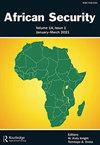The African Union and Human Protection: Towards a Regional Protection Regime
IF 1.3
Q2 POLITICAL SCIENCE
引用次数: 2
Abstract
ABSTRACT A global discourse of protection and responsibility suggests that human protection norms have gained traction. Empirically, this coincides with an observed global reduction in violence. How does this relate to regional protection practices in Africa; is there a regional protection regime? If so, how is this regime constituted, and what does it comprise? Does it shape regional protection practices, and if so, in what ways? This article describes the origins of human protection norms in Africa and assesses the role of the protection regime in shaping regional practices. An analytical framework based on regime theory, that assumes that the emergence of institutions and consistent practice indicates the emergence of a regime, is employed. An empirical survey of institutions and practices suggests the development of a regional protection regime. However, the regional structures differ from, and compete with, preexisting international structures. While the structural prerequisites for a regional protection regime are now in place, several factors interfere with the development of the regional protection regime. The article concludes with several observations. First, the incoherence of global and regional structures results in contradictions and duplication among institutions. Second, a lack of agency of local actors, owing to limited resources and understaffing, inhibits consistent protective responses. Third, resistance by some regional agents to the norms underpinning the protection regime. However, incoherence, inconsistency, and hypocrisy are common features of regimes. Consequently, the fact that the African human protection regime is characterized by incoherence, inconsistency, and hypocrisy undermines neither its significance, nor its ability to shape practice and promote human protection.非洲联盟与人类保护:建立区域保护制度
关于保护和责任的全球话语表明,人类保护规范已经获得了牵引力。从经验上看,这与观察到的全球暴力减少相吻合。这与非洲的区域保护做法有何关系?是否有区域保护机制?如果是这样,这个政权是如何构成的,又由什么组成?它是否影响了区域保护实践,如果是,以何种方式?本文描述了非洲人类保护规范的起源,并评估了保护制度在形成区域实践方面的作用。本文采用了一种基于制度理论的分析框架,该框架假定制度的出现和一贯的实践表明一种制度的出现。一项对制度和实践的实证调查建议建立一种区域保护制度。然而,区域结构不同于先前存在的国际结构,并与之竞争。虽然建立区域保护制度的结构性先决条件现已到位,但有几个因素妨碍了区域保护制度的发展。文章最后提出了几点看法。首先,全球和区域结构的不一致性导致各机构之间的矛盾和重复。第二,由于资源有限和人员不足,缺乏地方行动者的代理,阻碍了一致的保护反应。第三,一些地区代理机构对支撑保护制度的规范的抵制。然而,不连贯、不一致和虚伪是政权的共同特征。因此,非洲人类保护制度的特点是不连贯、不一致和虚伪,这一事实既没有削弱其重要性,也没有削弱其塑造实践和促进人类保护的能力。
本文章由计算机程序翻译,如有差异,请以英文原文为准。
求助全文
约1分钟内获得全文
求助全文

 求助内容:
求助内容: 应助结果提醒方式:
应助结果提醒方式:


